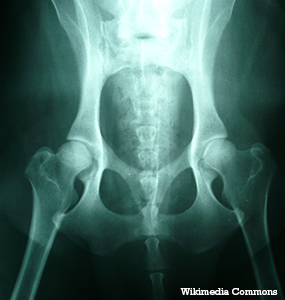
“Hip dysplasia.” As a dog owner, these are two words you don’t want to hear during a conversation with your veterinarian. Fortunately, advances in veterinary medicine and a range of management options make it possible to keep a dog with hip dysplasia happy and healthy for years to come. Below is an overview of the condition, followed by six methods of management and treatment that will be very helpful for parents of dogs with hip problems.
Overview and Causes
A common skeletal disease, hip dysplasia occurs when a dog’s hip joints don’t develop quite right, allowing the hips to partially dislocate. For a dog diagnosed with the condition, it can mean anything from painful wear-and-tear to extreme difficulty getting around.
What causes hip dysplasia? Mostly, it’s a genetic condition, though environmental and dietary factors also contribute to the problem. And while it tends to pop up in the bigger dog breeds like Great Danes, St. Bernards, Labrador and Golden Retrievers, and German Shepherds, dogs of all sizes and breeds are susceptible.
There are also some environmental factors that cause or worsen the condtion:
- Rapid weight gain and obesity, putting excessive strain on the joints.
- Nutritional factors
- Pelvic muscle mass
Symptoms and Diagnosis
If your dog shows signs of hip dysplasia, it will seem similar to the signs of arthritis – painful joints, difficulty moving, and general stiffness. In general, his hind-end will be lame and weak. It can occur in one or both hip joints. Here are some other symptoms to watch for:
- “Bunny-hopping” or swaying gait
- Weakness in one or both hind legs
- Pain when touched in hip or pelvis area
- A change in behavior: reluctance to rise/difficulty rising, unwillingness to play or climb stairs, exercise intolerance, reduced activity levels
- Audible clicking sound coming from hips while walking
- Shrinking of hind leg muscles (atrophy)
Recognizing symptoms early is important, and your vet can help you with this! It’s actually pretty simple to diagnose hip dysplasia: your vet will perform a physical exam, take some x-rays of your pooch, and possibly perform some manual tests on your dog’s hips and legs.
Prevention, Treatment, and Management
The bad news: there’s usually no way to prevent hip dysplasia because it is almost always inherited. The good news: there are tons of options when it comes to treatment and management.
There are several surgical options, usually reserved for when the condition is severe, including total hip replacement. For many dogs, however, the combination of a healthy diet, joint supplements, anti-inflammatory medications, maintaining a normal weight, and the right kind of exercise can do wonders for hip dysplasia. Check out our list of 7 common ways to manage hip dysplasia and keep your pooch comfortable!
If your dog is affected by hip dysplasia, your veterinarian will be your best resource and will help you put together a program to keep your dog healthy and happy far into the future.
If you have any questions or concerns, you should always visit or call your veterinarian – they are your best resource to ensure the health and well-being of your pets.
